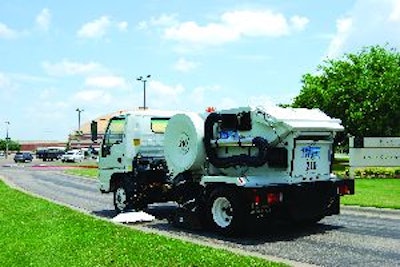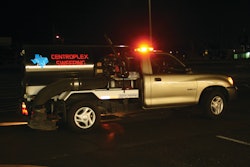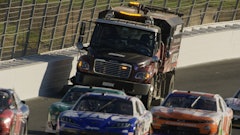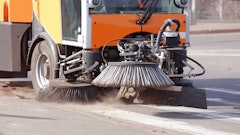
The sweeping season is about to pick up steam for northern contractors. Giving equipment a pre-season tune-up will allow for better performance on the job and less down time. Even for their southern counterparts, taking a little time to routinely check critical wear components and parts will help ensure optimum performance.
"There's no better time than now to give your sweepers a once over," says Casey Patterson, shop foreman for Michigan-based Superior Sweepers. "This is a slow time of year for most shop mechanics, and no matter what type of sweepers your company operates, there's always a list of items to check and double check.
Patterson says different types of sweepers require different types of maintenance and preventive service to get them ready for the season. "For broom trucks and other mechanical-type sweepers, check the chains for wear and stretching; check the sprockets, elevator pans, bearings, and hopper for rust damage. Give the hydraulic lines a 'once over' to ensure they're not cracked, and examine the hoist and cylinders to make sure the seals are not leaking and the chrome on pistons isn't pealing or pitted."
He adds that gutter broom pins and bushings; lift arms, tilt system, down pressure system, rear broom, and drag shoes all require inspection to ensure the sweeper is operating properly. Patterson's tune-up list also includes checking drive belts, changing hydraulic fluid, and adjusting the gutter broom. All hardware should be checked, too, including that which attaches latches and hinges. Replace missing or broken hardware, including clamps and springs, and remove any trash left over from the previous season.
Air sweepers, he adds, require a slightly different maintenance regimen. "Check the pick-up head for wear and sandblasting and replace the flaps," Patterson says. "Make sure all seals are working and the blower fan is in good shape. Make sure the hopper is in good shape. If it has a few holes the air system will lose its vacuum."
"Early spring can be especially demanding on sweepers used by northern contractors," adds David Zajicek, service school director for Waco, TX-based Tymco, manufacturer of regenerative air sweepers. "Picking up heavy, intense sand requires sweepers to be in top running condition. For air-type sweepers, first and foremost, that means seals need to be functioning properly and the blower in top condition."
Before taking to streets and parking lots for the first time this year, Zajicek, like Patterson, encourages contractors to check the inspection door seal, transition seals, dust separator seals, and seals on the dump door on their air sweepers. "Having a tight air seal around the pickup head is especially important," he adds. "Make sure these seals are good and that the pickup head is adjusted properly."
He adds that over time, blower wheels will wear and lose their efficiency. "Check the wheel for excessive wear and make sure the blower is moving enough air, something, again, that will be required to pick up debris left over from the winter months."
Oil and Water
Zajicek notes that the dust-controlling water system needs to be inspected to ensure that the spray tips and nozzles will be doing their job. "Even brass nozzles wear out over time," he adds "and while you're checking the water system check out the water pump, too. Maybe it's time for a new seal kit or a replacement pump."
Costas Cordonis, warranty/service manager for Schwarze Industries, Huntsville, AL, says most sweepers run hydraulically or have some type of hydraulic system to run different operations. (see sidebar) "Change the hydraulic oil and filters before spring startup and check the fluid level daily, even before starting the equipment," he says. "Check all fittings and hoses, too. If components need to be replaced, make sure to replace them with the correct parts. Replacing fittings or hoses with ones that have a smaller displacement will create flow restriction, back pressure, and system overheating."
Cordonis advises sweeping contractors to regularly change hydraulic oil and filters to avoid system contamination, which could cause premature wear, corrosion on the valves and pump and possibly lead to motor bearing failures. To prevent or minimize corrosion caused by rain and the salt spread this past winter, he encourages contractors to routinely apply dielectric grease on the coils and electrical plugs, a move that will help keep moisture out.
Tune-up Your Trucks, Too
Keeping trucks in top running order should be a top priority, too, Patterson says. "Contractors with older trucks in their fleet may need to take them to the dealer to adjust the fuel trim and timing. These specs are set at the factory and require specials tools to change," Patterson says.
"The maintenance procedure is well worth the cost. I have found that an out-of-adjustment engine can cost a contractor more than two gallons of fuel a night. Seven nights a week times 40 weeks, times $3.00 for a gallon of gas, adds up to a lot of extra costs. This service really needs to be performed at around 100,000 miles."
Patterson says that contractors can save a considerable amount of money by grouping their order for tires, brooms, fluids, filters, and other wear parts. If you're a member of the North American Power Sweeping Association make sure to ask for your discount, he adds.
One final thought from Patterson. "When conducting your spring tune-up, if you're in doubt about a particular part or sweeper component, replace it. A broken down sweeper will almost always cost you more than the repair would have."



![Pavement Awards 2025[main]](https://img.forconstructionpros.com/files/base/acbm/fcp/image/2024/05/PavementAwards_2025_main_.665883e4276e8.png?auto=format%2Ccompress&bg=fff&fill-color=fff&fit=fill&h=100&q=70&w=100)








![Pavement Awards 2025[main]](https://img.forconstructionpros.com/files/base/acbm/fcp/image/2024/05/PavementAwards_2025_main_.665883e4276e8.png?ar=16%3A9&auto=format%2Ccompress&bg=fff&fill-color=fff&fit=fill&h=135&q=70&w=240)







